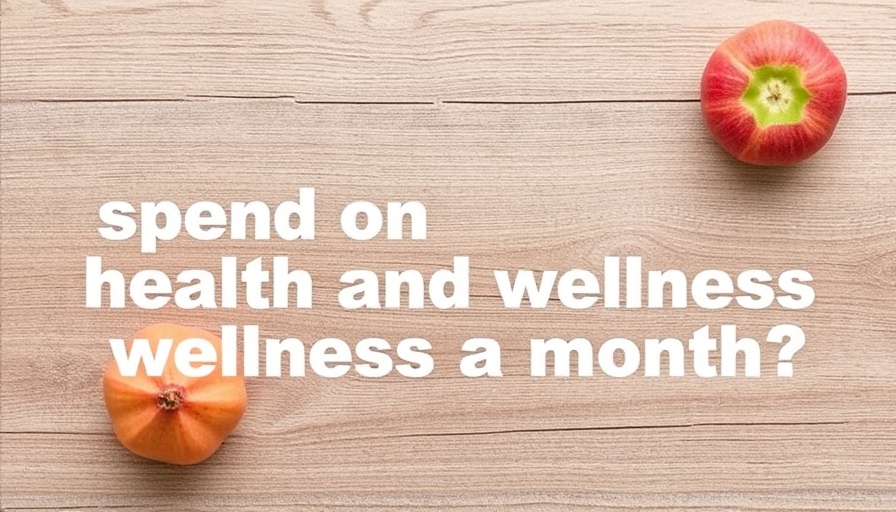
The Financial Impact of Health and Wellness in Today’s Society
When considering the expenditure on health and wellness, it can be surprising to learn that Americans invest an average of $6,000 annually, as reported by the Global Wellness Institute. This staggering figure makes the United States the largest wellness economy in the world. However, it's not just in the U.S.; across the pond, the UK follows closely as the fifth largest, with an average spend of $3,342 per person annually. This spending spans various categories, showcasing how individuals approach wellness differently.
Understanding What Health and Wellness Means to You
Health and wellness encompass a wide range of aspects, varying significantly from person to person. For many, it can include the basics like nutritious groceries, memberships to fitness classes, or even alternative solutions like naturopathic treatments and herbal supplements for holistic health. Others may prioritize mental health resources, such as therapy and meditation apps. As we survey the diverse investment in various wellness categories, it’s crucial to reflect on what health and wellness means for you.
Diving Into Spending Categories: A Closer Look
According to a survey highlighted by StyleSeat, Americans allocate their wellness budgets predominantly on beauty, fitness, and wellness services. On average, a consumer spends about $110 monthly across these categories, with beauty taking the largest share at approximately $46, followed by fitness at $34, and wellness services at $30. Such data reflects a cultural shift towards prioritizing self-care despite rising costs.
Demographic Insights: Who Spends More?
Interestingly, spending habits vary considerably among demographics. Women and nonbinary individuals reported higher expenditures, averaging $124 and $114, respectively, whereas men spent around $94. Millennials lead the pack, consistently increasing their investments in beauty, fitness, and wellness products. This generational trend indicates not only a cultural shift towards self-care but also a recognition of the long-term value of health investments.
Inflation Doesn’t Halt Wellness Spending
Despite the economic pressures of inflation, a notable 71% of survey respondents express intent to maintain or even boost their wellness spending. This indicates that the prioritization of physical and mental health continues unabated. Even when budgets tighten, many consumers refuse to compromise on their well-being, with almost one in four reporting an increase in wellness spending over recent years.
Fostering Community Health and Wellness
Communities play a pivotal role in promoting health and wellness. Participation in local wellness events or initiatives can lead to a more extensive understanding of what optimum health looks like. Events can range from community fitness classes to health seminars focusing on lifestyle medicine and preventive care. Engaging with local health and wellness resources not only strengthens community bonds but also enhances individual wellness journeys.
Empower Yourself with Knowledge
With an expansive array of health and wellness articles, blogs, and resources available, it’s easier than ever to gain insights into personal wellness spending. Blogs that delve into optimal health and wellness can provide valuable tips on how to allocate your budget effectively, whether that means investing in nutritional supplements or fitness classes. Educating yourself can facilitate informed decisions on how to approach spending in ways that yield the most significant returns on your investment.
Holistic Approaches to Spending Wisely
Considering a complete view of health and wellness can lead to more holistic spending. Perhaps a portion of your budget can go towards mental health services, while another fraction supports physical fitness. The key is to tailor spending to fit personal health objectives. Whether exploring yoga and naturopathy, investing in wellness books, or experimenting with herbal remedies, making informed decisions impacts overall well-being in a tangible way.
Take Action to Enhance Your Wellness
Now that you have insights into how much others are spending on health and wellness, consider reflecting on your own habits. What adjustments can be made to enhance your overall well-being? Whether it’s prioritizing fitness, educating yourself on nutrition, or seeking mental health support, taking the first step toward optimizing your wellness is vital. Join the conversation about health and wellness spending in our community callout and share your perspective today!
 Add Row
Add Row  Add
Add 




 Add Row
Add Row  Add
Add 


Write A Comment